The elaborate and cruel tortures lasted for months. The reduced tariff was not even applied to pregnant women or children. During the times of Stalinist terror, tens of thousands of people lost their lives in prisons, pre-trial detention centers and labor camps when subjected to brutal investigative methods.
The Ubecs were real monsters. They were demoralized, emotionally unstable, alcoholics and illiterate people. They changed the lives of their victims into hell, which was summed up by the martyrdom tormented by months. Witold Pilecki: I can't live anymore [...], I'm exhausted. Because Oświęcim was a game .
Bird is supposed to sing
The security apparatus established in 1944 was an armed arm of the communists necessary to maintain power in Poland. The Ministry of Public Security had enormous funds, exceeding the budgets of many other key ministries. At the end of 1944, the secret police employed about 2,500 people, a year later about 24,000, and in 1953 - over 33,000 officers enjoying many privileges.
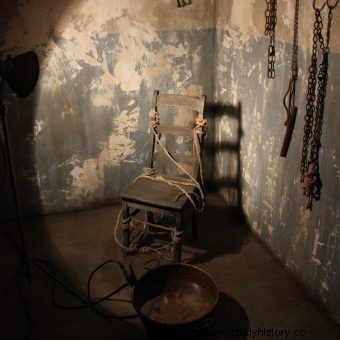
The UB torturers did not look any better (photo:Klearchos Kapoutsis, CC BY 2.0).
We do not know the exact number of those arrested by the security services for so-called anti-state activities. According to the data of the then Department of Corrections, in the period 1945–1953 about 1,000,000 people passed through prisons and camps. The Minister of Public Security, Stanisław Radkiewicz, commented on the methods of operation of the security apparatus:
the authority of force, violence, is a reserve, one should resort to authority when it is necessary to beat, arrest or imprison. Then the attitude must be absolute.
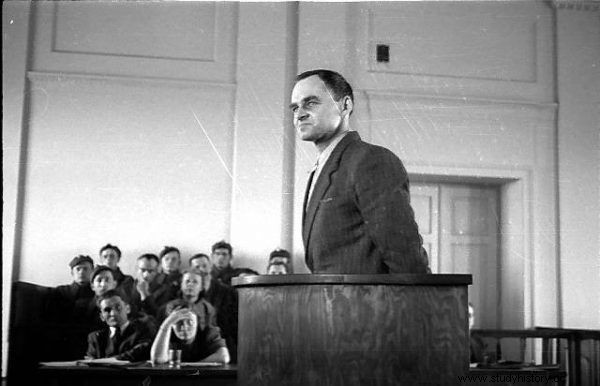
Witold Pilecki during the trial. Soon he was about to be sentenced to death and oblivion (photo:public domain).
In a absolute stance the director of the Investigative Department (III) of the Ministry of Public Security, Col. Józef Różański, believed that the bird should sing . He was a sadist enjoying the torture of prisoners. Włodzimierz Lechowicz heard from him:
You will die when we want to, but before that you will curse the moment your mother gave birth to you a hundred times. We will rip your veins and break your bones, and in the other room we will put them back together - until we are done and for as long as we want.
49 kinds of torture
The secret executioners kicked and beat the interrogated with fists, as well as with whips, rubber-coated ropes, rubber clubs, leather belts with metal buckles, key rings or rifle butts. Kazimierz Moczarski, during the occupation, head of the Information and Propaganda Bureau of the Home Army Headquarters, experienced as many as 49 types of torture.
The writer mentioned them in a letter to the Supreme Prosecutor's Office of the Polish Army in Warsaw of February 24, 1955. In addition to the most sophisticated ways of beating, he also listed, among others, pulling hair from various parts of the body (including the genitals), crushing fingers, pulling nails, burning with a flame or a cigarette and sleep deprivation for many days.
The investigative methods of the UB were also well remembered by Stanisław Krupa, a former soldier of the Home Army's "Zośka" Battalion, imprisoned in the infamous 10th Pavilion of the Mokotów prison on Rakowiecka Street in Warsaw. His account is quoted in his book "Heroes from the pits of death" by Waldemar Kowalski:
When my tormentors found the beating no longer affected me, they resorted to a different method. My hands and feet were tied and put on a hook (...). God, what a horrible torture it is! The entire weight of the body rests on the centimeter-thick tip of a bent (...) iron hook in the wall. In addition, they seat you so that you lean on your tailbone. Even a slight movement causes the hook to dig into the rectum.
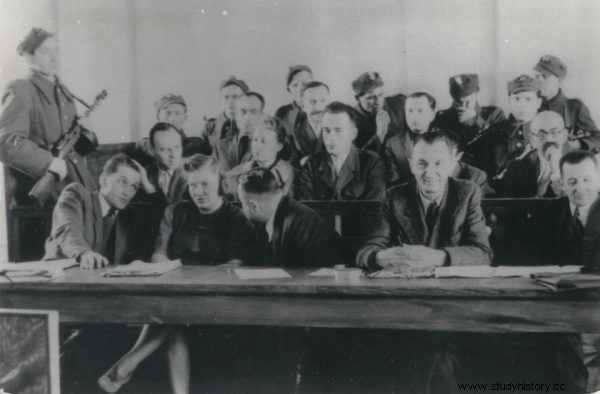
The dock of defendants during the trial of Witold Pilecki and his associates, including Tadeusz Płużański, 1948 (photo:public domain).
A popular method of "revealing the truth" was also keeping a prisoner in a wet or dry chancellor. In the first case, the cell was filled with water or a septic tank. General August Emil Fieldorf "Nil" spent three weeks in such conditions. In the second variant, the prisoner sat in total isolation, in the twilight, in his own excrement for days.
You will go to Birkenau
The torturers had no mercy even for pregnant women and children . In July 1955, Tadeusz Płużański revealed the terrifying details of the investigation in a letter sent from the prison in Wronki to the Council of State of the People's Republic of Poland:
My wife was treated with a system of maltreatment, flooding gutter inventions with a stream, trampling her female dignity. She was blackmailed that if she didn't sign everything they put her to sign, I would be shot.
Stanisława Płużańska was then pregnant. She had a miscarriage due to torture and received no medical treatment. Extremely exhausted, she was losing consciousness, delirious, screaming. She recovered in the prison hospital in Grudziądz, where a nearly dying woman was taken care of by a local doctor.
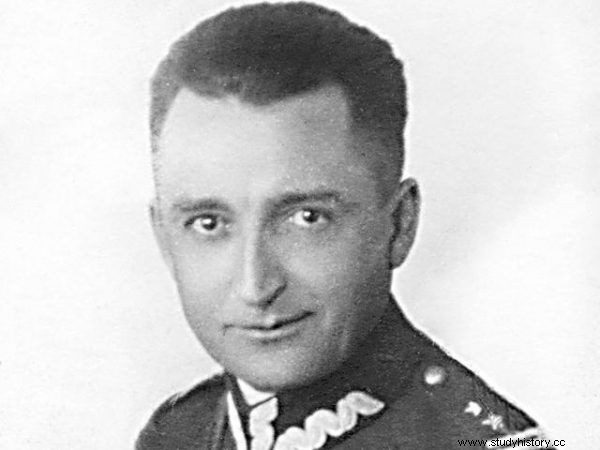
Gen. August Emil Fieldorf "Nil" was tortured and then hanged in the prison on Rakowiecka Street (photo:public domain).
Even the children were not treated leniently. The Institute of National Remembrance in Lodz charged two security officers - Tadeusz Król and Tadeusz Molenda - with allegations of physical abuse of high school students in Piotrków Trybunalski and Wolbórz, who distributed independence leaflets.
During many hours of interrogation, the King beat the boys with his fists, a piece of cable and a rubber truncheon. He tied them upside down to the bar, then kicked them on the head and ribs. On the other hand, Molenda liked to beat the same children hanging from the buttocks with a cable. Moreover, the case file states that:
[students - A.B.-R.] had their hands tied at their wrists, having previously put them under their feet, and after putting the stick under their arms, they were hung [...] between two desks,
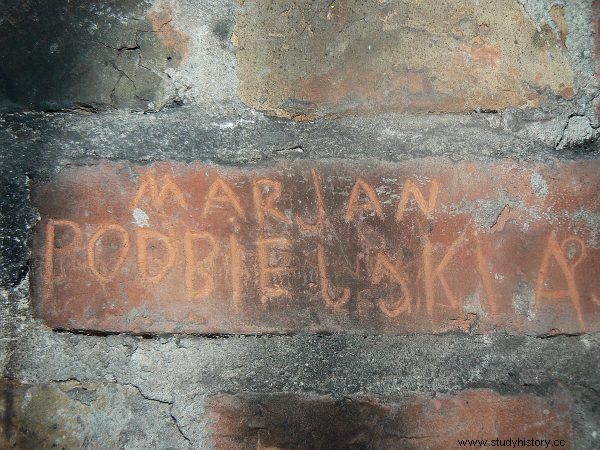
An inscription carved by one of the prisoners in one of the cells of the former seat of the Provincial Public Security Office in Warsaw, in a tenement house at 8 Strzelecka Street (photo:Kacper.jackiewicz.1998, CC BY-SA 3.0 PL).
Some interviewees were not even 15 years old. And the nightmare was just beginning for them. In the summer of 1951, most of the teenagers were sentenced, and they were to serve their sentence in the "re-education" camp in Jaworzno. Jerzy Biesiadowski, one of the tortured boys, and in the Third Republic of Poland an auxiliary prosecutor in the trial of his torturers, reported:
The prisoners remembered Commandant Salomon Morel well. During the first appeal, he said to us:“You will not survive, you will go to Birkenau. Unless you obey. ”
Jerzy Kmiecik added:
In greeting, Morel said:" You didn't come here to live, but to rot ". I thought we ended up in Oświęcim.
Among the few perpetrators who were caught by justice after many years, was also Mieczysław Wyraniec, sentenced to 6 years in prison, although the prosecutor demanded a higher penalty. He was allegedly so cruel that even his colleagues called him the executioner, and his superiors punished him for having tortured the interrogated person during the investigation. Only one of the battered prisoners survived the sentence.
Bandit naked down
According to the findings of the Institute of National Remembrance, over 8,000 death sentences were issued in Poland during the Stalinist period. Almost 5,900 of them were ruled by military courts (almost 50% were executed). One of the witnesses quoted by Władysław Kowalski in " Heroes from the pits of death ”Described the course of the execution:
(...) at least three guards led the condemned man to the old boiler room in the southwest corner of the prison yard. Held by two guards, he entered. When he crossed the threshold - a shot was fired in the back of the head, in the back of the head. Usually one shot was enough. Those who killed were skilled, did not miss, they smashed the brain with the first shot.
The dead and the dead were divided into four categories:those who died in prison, suicide, executed under the sentence, and "bandit", usually a soldier of the independence underground. Only the bodies of suicides and those sentenced to death were allowed to be released by the governor to the family with the consent of the head of the WUBP, after consultation with the local prosecutor. Others ended up in nameless graves.
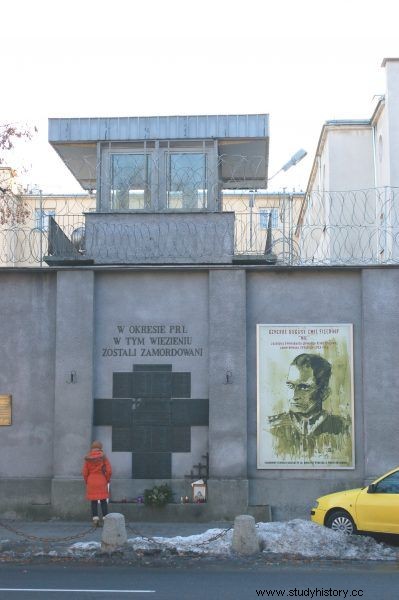
A plaque commemorating the victims of the Rakowiecka prison placed on its walls (photo:Wistula, CC BY-SA 3.0).
The bodies were buried in places of execution or in unattended, secluded areas, such as Pola Mokotowskie or Las Kabacki. In the first years of Stalinism, the murdered also ended up in the area of the Horse Racing Track in Służewiec. It was especially disgraceful rummaging in landfills or in sewage pits . The "bandits" were often handed over to anatomy units, where their remains were used as exercise material for medical students.
From the spring of 1948, the place of burial for the murdered was the area next to the wall of the Powązki Cemetery, that is today's "Łączka". Up to two-meter pits were still dug during the day. Prisoners were buried without coffins, often several in one pit, naked or in underwear, sometimes in paper cement bags. It happened that they were dressed in Wehrmacht uniforms.
According to the account of the guard, Władysław Turczyński, who bury the bodies of prisoners, almost 300 people are buried there. What about the rest? The historian Krzysztof Szwagrzyk wrote that in the years 1944–1956 over a thousand people died in Mokotów alone. There are also hundreds of victims from prisons in Białystok, Kraków, Lublin, Wrocław and other cities.
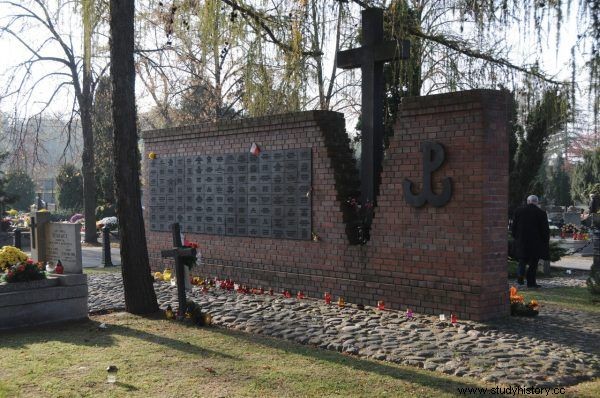
The quarters in the meadow at the Powązki Military Cemetery, where many victims of the Mokotowski Prison on Rakowiecka are buried (photo:Zlisiecki at pl.wikipedia, CC BY-SA 3.0).
Families often did not know how their loved ones died, and in many cases do not know their final resting places to this day. So far, the remains of about 200 people have been found in "Łączka", and 40 of them have been publicly informed. Dr. Szwagrzyk is in charge of the exhumation work. He told the author of "Heroes from the pits of death" that today it is a holiday for Poles.
***
"Heroes from the pits of death" is a publication devoted to people who "live", although they have been murdered a long time ago. Judged, but deprived of the right to defense. Those about whom - if we look at the intentions of the executioners - we were to speak only in passing, seeing them as bandits, common criminals, traitors of the nation, anti-state pests. The heroes who died in the casemates of the Mokotów prison after reading the operative part, allegedly "on behalf of the Republic of Poland".
